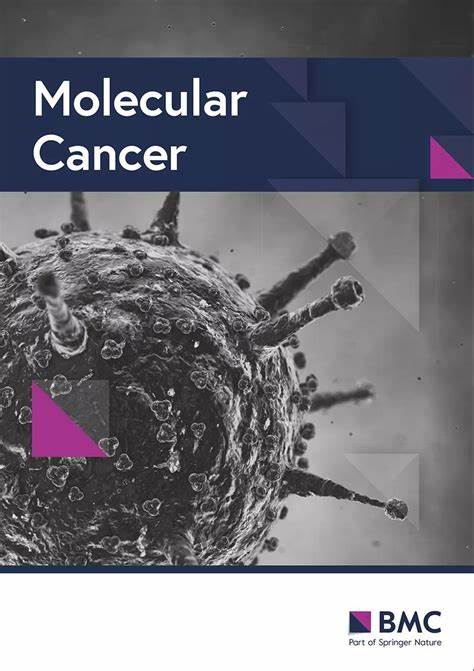HPGD通过LXA4-ERK1/2-U2AF2-TFRC轴诱导铁下垂和自噬抑制食管鳞状细胞癌
IF 33.9
1区 医学
Q1 BIOCHEMISTRY & MOLECULAR BIOLOGY
引用次数: 0
摘要
虽然已知15-羟基前列腺素脱氢酶(HPGD)调节前列腺素和脂素A4的代谢,并且其失调与多种癌症有关,但其在食管鳞状细胞癌(ESCC)中的作用尚未确定。该研究首次全面表征了ESCC中HPGD的表达,并确立了其在预测患者预后方面的临床相关性。此外,我们阐明了以前未被认识的HPGD抑制ESCC进展的分子机制及其作为新的治疗靶点的潜力。对已故ESCC患者的配对肿瘤和邻近正常组织进行转录组测序,以确定差异表达基因。随后在两个独立的大规模ESCC患者队列中验证了HPGD基因的差异表达,并评估了其预后意义。为了评估HPGD在ESCC中的功能作用,我们在ESCC细胞系中过表达该酶,并进行了一系列体外实验来评估其对细胞增殖、凋亡、侵袭和迁移的影响。为了阐明HPGD作用的分子机制,我们进行了转录组测序来分析ESCC细胞中基因表达的变化。通过多种分析,包括脂质过氧化、细胞内铁离子和活性氧(ROS)水平的测量、双荧光流式细胞术检测自噬、磷蛋白微阵列、生物素拉下实验和染色质免疫沉淀(ChIP),我们证明了HPGD主要通过诱导铁凋亡和自噬来调节ESCC细胞的恶性表型。最后,利用裸鼠皮下异种移植模型验证了HPGD对ESCC肿瘤生长的影响。HPGD在ESCC组织中的表达明显低于正常组织,且与肿瘤细胞分化和患者预后呈负相关。HPGD过表达抑制ESCC细胞体外和体内异种移植物肿瘤的增殖、侵袭和迁移。体外实验表明,HPGD通过促进脂素A4 (LXA4)降解来抑制ERK1/2的激活。这种抑制促进了rna结合蛋白U2AF2与转铁蛋白受体(TFRC)启动子区域的结合,从而增加了TFRC的表达。因此,这些改变导致细胞内铁积累并引发铁下垂。铁下垂过程中ROS的过量产生通过AMPK/mTOR信号通路导致自噬过度激活。减轻hpgd诱导的TFRC上调或减少ROS产生可有效逆转铁下垂,防止过度自噬,改善恶性细胞表型。HPGD通过LXA4-ERK1/2-U2AF2信号轴促进铁凋亡,进而通过AMPK-mTOR途径诱导自噬过度激活,从而发挥其抗肿瘤作用。这些研究结果表明,HPGD是食管鳞状细胞癌(ESCC)的一个有希望的治疗靶点,并揭示了rna结合蛋白U2AF2通过转录因子的作用调节TFRC表达的非经典作用。本文章由计算机程序翻译,如有差异,请以英文原文为准。
HPGD induces ferroptosis and autophagy to suppress esophageal squamous cell carcinoma through the LXA4–ERK1/2–U2AF2–TFRC axis
Although 15-hydroxyprostaglandin dehydrogenase (HPGD) is known to regulate the metabolism of prostaglandins and lipoxin A4, and its dysregulation has been implicated in various cancers, its role in esophageal squamous cell carcinoma (ESCC) has not been determined. This study is the first to comprehensively characterize HPGD expression in ESCC and establish its clinical relevance in predicting patient outcomes. Furthermore, we elucidated the previously unrecognized molecular mechanisms through which HPGD suppresses ESCC progression and its potential as a novel therapeutic target. Transcriptome sequencing was performed on paired tumor and adjacent normal tissues from deceased patients with ESCC to identify differentially expressed genes. The differential expression of the HPGD gene was subsequently validated in two independent, large-scale ESCC patient cohorts, and its prognostic significance was evaluated. To evaluate the functional role of HPGD in ESCC, the enzyme was overexpressed in ESCC cell lines, and a series of in vitro assays were conducted to assess its effects on proliferation, apoptosis, invasion, and migration. To elucidate the molecular mechanisms underlying the effects of HPGD, we performed transcriptomic sequencing to profile gene expression changes in ESCC cells. Through multiple analyses, including measurements of lipid peroxidation, intracellular ferrous ion and reactive oxygen species (ROS) levels, dual-fluorescence flow cytometry for autophagy, phosphoprotein microarrays, biotin pull-down assays, and chromatin immunoprecipitation (ChIP), we demonstrated that HPGD regulates the malignant phenotype of ESCC cells primarily by inducing ferroptosis and autophagy. Finally, the impact of HPGD on ESCC tumor growth was validated in vivo using a subcutaneous xenograft model in nude mice. HPGD expression was significantly lower in ESCC tissues than in normal tissues and was negatively correlated with tumor cell differentiation and patient outcomes. HPGD overexpression inhibited ESCC cell proliferation, invasion, and migration in vitro and in xenograft tumor growth in vivo. In vitro experiments demonstrated that HPGD suppresses ERK1/2 activation by facilitating lipoxin A4 (LXA4) degradation. This inhibition facilitates binding of the RNA-binding protein U2AF2 to the promoter region of the transferrin receptor (TFRC), thereby increasing TFRC expression. Consequently, these alterations lead to intracellular iron accumulation and initiate ferroptosis. Excessive generation of ROS during ferroptosis results in hyperactivation of autophagy via the AMPK/mTOR signaling pathway. Mitigating the HPGD-induced upregulation of TFRC or reducing ROS production effectively reverses ferroptosis, prevents excessive autophagy, and ameliorates malignant cell phenotypes. HPGD exerts its antitumor effects by promoting ferroptosis through the LXA4-ERK1/2-U2AF2 signaling axis, which in turn induces autophagy hyperactivation via the AMPK-mTOR pathway. These findings suggest that HPGD is a promising therapeutic target for esophageal squamous cell carcinoma (ESCC) and reveal the nonclassic role of the RNA-binding protein U2AF2 in regulating the expression of TFRC by acting like a transcription factor.
求助全文
通过发布文献求助,成功后即可免费获取论文全文。
去求助
来源期刊

Molecular Cancer
医学-生化与分子生物学
CiteScore
54.90
自引率
2.70%
发文量
224
审稿时长
2 months
期刊介绍:
Molecular Cancer is a platform that encourages the exchange of ideas and discoveries in the field of cancer research, particularly focusing on the molecular aspects. Our goal is to facilitate discussions and provide insights into various areas of cancer and related biomedical science. We welcome articles from basic, translational, and clinical research that contribute to the advancement of understanding, prevention, diagnosis, and treatment of cancer.
The scope of topics covered in Molecular Cancer is diverse and inclusive. These include, but are not limited to, cell and tumor biology, angiogenesis, utilizing animal models, understanding metastasis, exploring cancer antigens and the immune response, investigating cellular signaling and molecular biology, examining epidemiology, genetic and molecular profiling of cancer, identifying molecular targets, studying cancer stem cells, exploring DNA damage and repair mechanisms, analyzing cell cycle regulation, investigating apoptosis, exploring molecular virology, and evaluating vaccine and antibody-based cancer therapies.
Molecular Cancer serves as an important platform for sharing exciting discoveries in cancer-related research. It offers an unparalleled opportunity to communicate information to both specialists and the general public. The online presence of Molecular Cancer enables immediate publication of accepted articles and facilitates the presentation of large datasets and supplementary information. This ensures that new research is efficiently and rapidly disseminated to the scientific community.
 求助内容:
求助内容: 应助结果提醒方式:
应助结果提醒方式:


